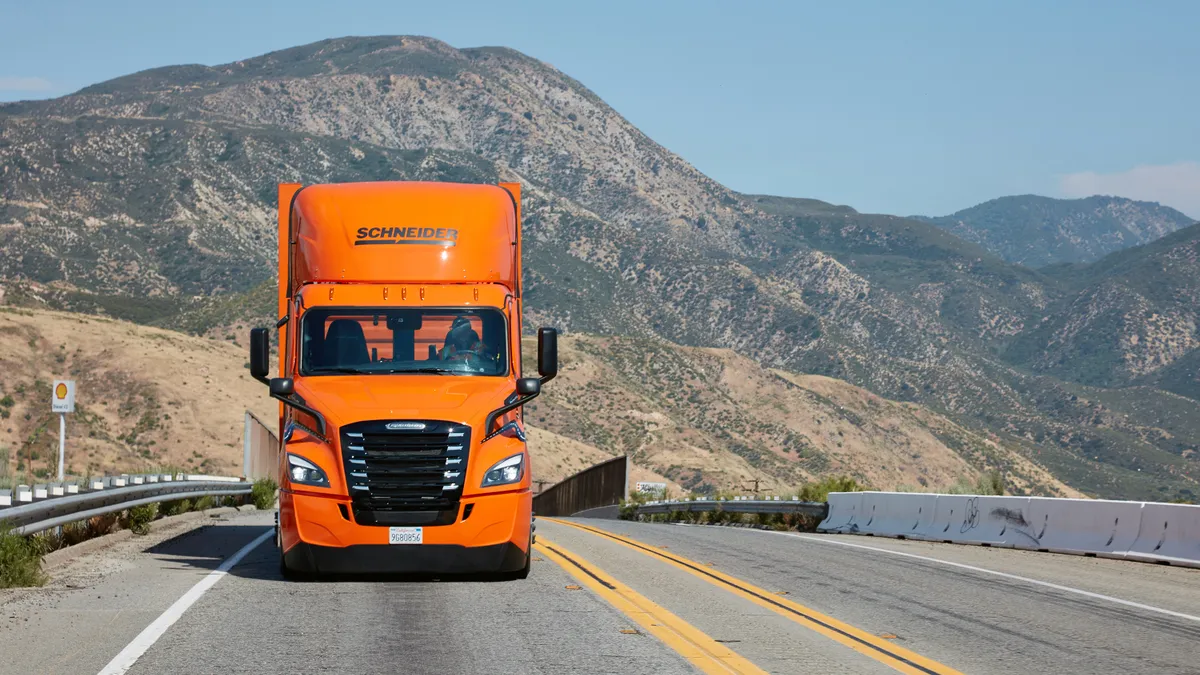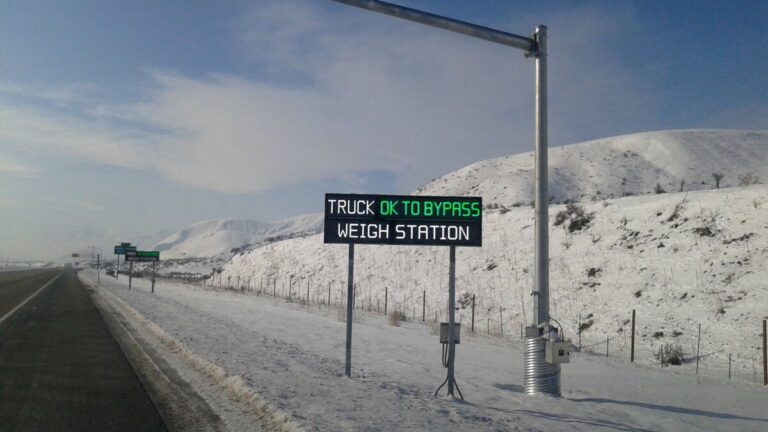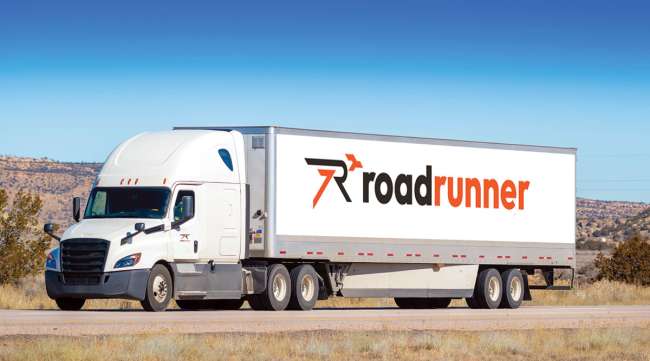LANCASTER, Texas — An autonomous tractor-trailer steered itself onto Interstate 20, safely merged into dense traffic, and later slowed down to 48 mph when approaching a car stopped on the highway’s shoulder.
Kodiak Robotics safety driver Robert Roland’s hands hovered over the wheel, prepared to intervene if necessary, while the company’s technology navigated traffic, hazards and ramps — as well as local streets near its terminal — during a morning demo ride near Dallas in May.
“It’s a totally different world,” the third-generation truck driver said.
As Kodiak Robotics and Aurora Innovation prepare to operate their autonomous vehicles on public roads without safety drivers, which could happen later this year in Texas, Trucking Dive visited the companies’ sites for an up-close look at their progress toward full autonomy.
Self-driving trucks have been pulling customer freight in tests on public roads under the supervision of safety operators like Roland, and the ride provided a glimpse into the trucks’ potential readiness for real-world driving scenarios.
“They drive defensively. They drive cautiously,” Kodiak Director of External Affairs Daniel Goff said.

A focus on safety first, “PERIOD”
Kodiak’s system is designed to be courteous to other drivers, slowing down and letting vehicles merge.
“The system is designed to treat unknown objects as a human would: with extra care,” Goff said.

At the company’s Lancaster, Texas, operations hub, Director of Operations Don Lepard pointed out a map on a wall that shows routes where Kodiak has delivered freight for a customer for revenue. A lowercase “k” appears in places across California, Florida, Georgia, Oklahoma and Texas.
On another wall, a message says, “Safety first and always. PERIOD.”
In nearby Palmer, Texas, Aurora staff stress safety efforts at a busy AV terminal as well as the company’s technology.
Aurora trucks can operate in fog and light rain and have strong capabilities even in torrential downpours, President Ossa Fisher said in an interview there.
But deployment in ice and snow may take a few years, she said. Fisher likened self-driving trucks’ precautions to when airlines decide not to fly because of hazardous weather conditions.
“We believe that will actually increase road safety,” she said, “because right now, there are trucks on the road and conditions that really nobody should be driving.”
At the Mid-America Trucking Show in March in Kentucky, Aurora Senior Safety Specialist Bryan Jones stressed the company’s emphasis on safety, noting that efforts seek to foster continuous improvement.
Aurora believes it “can always be safer and always strive” to improve the company and its technology, he said.
The company is developing a safety case and reported its autonomous readiness measure was 95% complete as of mid-April. Aurora is seeking to make that 100%.

Running operations now and in the future
Like Kodiak, Aurora uses pairs of people to ride in the trucks, and Aurora specialists like Zach Riley monitor the technology with a laptop in the truck to see how the system is observing the environment, traffic and hazards.
Riley noted how a sensor on Aurora’s lidar, short for light detection and ranging, can see objects over 400 meters away. On a recent trip, the technology saw through fog and recognized and responded to upcoming traffic before Riley could even see it, he recalled.
With the technology’s ability to enhance a vehicle’s navigation of traffic environments, Riley likens it to a superpower. He said he wished he could have the technology in his own car.
Proponents of the technology say there will still be work for drivers even after autonomous operations take hold.
At Aurora’s terminals, CDL holders perform Commercial Vehicle Safety Alliance inspections before the trucks embark each day.
“We will always have a need and be using truck drivers,” Jones said at MATS.
He noted with all the moving parts at terminals, there’s always going to be risk, but company staff “also believe that we can manage the risk down by implementing smart solutions that we’ve seen work across other spaces.”
Jones also said safety training is not merely a one-time session that’s never revisited: Instead, he and Aurora’s safety team visit the terminals routinely to ensure that the training is fresh.

Safety assessments continue to unfold
The National Highway Traffic Safety Administration has required those involved with autonomous operations to provide details on crashes, helping track the safety record of companies through a public database.
The incidents do not necessarily mean an autonomous vehicle was at fault, and the database has provided details on incidents for a nearly three-year period as of April. Manufacturers and operators must report the information to NHTSA.
Kodiak, which recently recorded 3 million miles of real-world operations with its technology, has reported only three incidents. All the incidents happened when trucks were being operated by a driver in manual mode, and no injuries were reported.
In one incident in October 2023 on a highway in Fort Worth, a Kodiak truck was traveling 34 mph by a safety driver while a Class 8 semi was encroaching on its lane, the company said in a NHTSA summary. Minor contact scratched a mirror-mounted SensorPod, and the AV safety driver pulled over.

The NHTSA crash database lists six Aurora incidents, most of which occurred when the vehicle was operating autonomously, according to crash summaries. Like with Kodiak, none of those or crashes had any injuries reported.
A collision in March on a west Texas highway captured how the technology can handle problems. An Aurora truck was traveling autonomously at 64 mph when a car veered into the lane of the truck and collided with the left rear of the trailer, per an NHTSA summary. Both vehicles were eventually able to leave the scene.
Nevertheless, the potential for more dangerous situations is raising concern among truckers.
“We’d like to see as much restriction and oversight as what we see on drivers who have already proven themselves,” Owner-Operator Independent Drivers Association EVP Lewie Pugh said, noting how a top-performing trucker can drive millions of miles safely.
The public should not be guinea pigs in testing on roadways, an OOIDA spokesperson said in an email.
Werner Enterprises SVP of Van and Expedited Chad Dittberner said setting a safety standard is a tough issue to address, noting the carrier has over 600 drivers currently who have driven over 1 million miles without a single accident.
Dittberner, a member of the Kodiak Industry Advisory Council, said safety is Werner’s priority for AVs and the rest of its fleet.
“The ultimate goal is a truck that’s never involved in an accident,” he said, “which is the same goal we have with our drivers today.”
source:https://www.truckingdive.com










